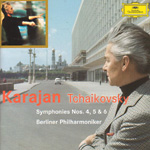Even as far back as the mid-1960s (when these recordings where made) Herbert von Karajan had the Berlin Philharmonic sounding (for better or worse) like no other orchestra. The Karajan qualities are unmistakable: the bright and thin brass that make even trombones and tuba sound shrill and high; his peculiar way of highlighting the horns in wind chord textures to add a certain element of aggressiveness, whether the composer intended it or not; and let’s not forget his near-manic obsession with plush strings as the dominant orchestral textures.
So, despite Karajan’s uncharacteristic fluidity of tempo and emotional expressiveness in the Symphony No. 4 (the best of the three readings), his gloomy and autumnal rendition of the Fifth (he doesn’t budge one bit on the tempo of the Andante’s second subject, even as the music ascends to its climax), or his emotional ambivalence in the Pathétique (the first movement plays rather stiffly, with foursquare phrasing and practically no rubato) these performances are less about Tchaikovsky’s emotional catharsis than about Karajan’s determination to render the scores with all the voluptuous orchestral sonority he can muster.
The next decade would introduce a new, darker element into Karajan’s Tchaikovsky, and his 1970s DG set (also available as a two-fer) will be preferred by many for its generally more penetrating and incisive readings. However, those bizarre sounding Philharmonie-based recordings, with their artificially close perspectives and squashed dynamics, are a real drawback. The present set benefits from the (relatively) more natural sounding perspective afforded by the spacious acoustic of Berlin’s Jesus-Christus-Kirche. And even if these recordings are a bit stingy on the bass, they probably give you a better idea of what this orchestra and conductor actually sounded like. Ultimately, this is a release for fans; for Tchaikovsky, you can certainly do better.
































